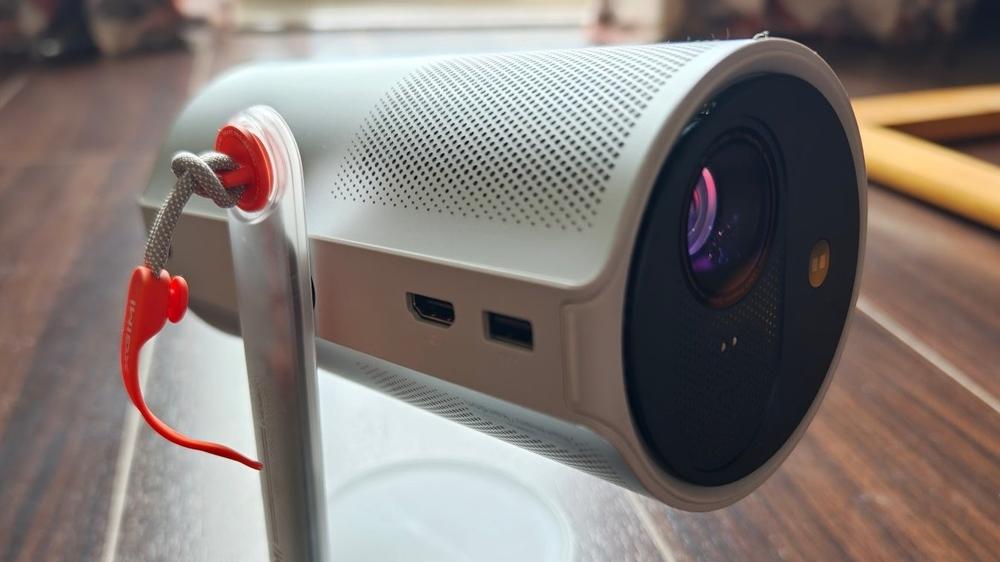Portable projectors often feel like a losing game: some end up compromising picture quality for a travel-friendly design, some are too bulky to carry, and some just don’t last long enough for a cord-free movie night. Xgimi is one of the very few brands that has come close to balancing the portability-performance equation, and with its new Mogo 4 series, it’s bringing that formula to an even more compact form factor.
The latest Mogo 4 and Mogo 4 Laser projectors improve upon their predecessors with a range of much-needed upgrades, while still being no bigger than a chunky water bottle. Most notably, there’s now an integrated battery that can last a two-and-a-half-hour movie, a refreshed built-in stand that rotates 360 degrees, and a full-size HDMI port. At a starting price of $499, they’re $50 more expensive, too, with the Laser variant going all the way up to $799. I’ve been testing the Mogo 4 Laser for weeks, and it offers an all-around portable projector experience.
Xgimi Mogo 4 Laser – Design and Build
The Mogo 4 Laser comes encased in the same familiar, cylindrical housing you’ll find on several of its peers. Though it’s made out of plastic, Xgimi has added a faux metallic finish that makes it appear more premium than it is and complements the speaker grills well, while keeping the body fairly light. That said, because of the battery, the Mogo 4 Laser is a tad heavier than before, and I could feel that heft on my shoulders when it was in my tote bag.
What’s nicer is a handful of thoughtful elements Xgimi has come up with to make the most of the portable design. The Mogo 4 Laser, for starters, sits on a 360-degree stand that allows me to comfortably project on the ceiling.
The side rail itself feels sturdy and, more importantly, can be pushed down to close the gap between the projector and the stand’s base. In this mode, it’s not only easier to carry the Mogo 4, but it also enables it to double as a Bluetooth speaker. The base has a translucent exterior and illuminates to provide ambient lighting, which can even be configured to respond to music. I also appreciated that the hinge has a lanyard you can attach the bundled, infrared mini remote to -- perfect for someone like me who nearly always forgets to pack the full-size one.
Speaking of which, the Mogo 4 Laser has two remotes: a tiny infrared clicker with only a D-Pad and volume controls, and another Bluetooth one with the usual collection of projector options, including buttons for entertainment apps, custom shortcuts, auto-focus, Google Assistant, and more. One feature I particularly liked about the standard remote is that some of its keys are backlit, a perk absent even on far more expensive projectors.
Other than that, the Mogo 4 Laser has a clean look, which helps it disappear into the rest of my room’s decor. There are three ports on its sides: an HDMI, a USB-A, and a USB-C.
Xgimi Mogo 4 Laser – Software and Performance
The Xgimi Mogo 4 Laser runs on Google TV and, unlike many mid-range projectors, supports a licensed version of Netflix. This means you can play all the mainstream entertainment apps at their best, including streaming HDR-compatible content. All the usual Google TV features are available, as well, such as global voice search and a personalized home screen. You won’t find much Xgimi bloatware either, apart from a couple of apps and settings like the ones for the ambient lighting.
The 2GB of RAM may seem inadequate, but in my testing, the software ran smoothly, and I didn’t have any major hiccups with the performance. It didn’t take long to set it up either, as I could log in and connect to the Wi-Fi from my Android phone.
Like most Xgimi projectors, the Mogo 4 Laser offers an exhaustive suite of keystone options. It can, of course, automatically adjust to whatever you are projecting at and avoid objects, but what sets it apart is that it lets you digitally manipulate the projection without adjusting the projector itself. You can apply digital zoom and move the projection to adapt to, for example, an awkward wall, like the uneven one I have in my bedroom. I also found the eye protection option handy, which automatically pauses the projection when someone interrupts it instead of blinding them.
Xgimi Mogo 4 Laser – Picture quality, speakers, and battery life
Much of the $200 difference between the Mogo 4 Laser and the standard Mogo 4 goes towards an upgraded projection tech. The Mogo 4 Laser, as the name suggests, is equipped with a triple-laser light source, and it makes a world of difference in the picture quality it delivers.
Compared to last year’s model and the Mogo 4, the Laser variant’s projection is about 25% brighter (550 ISO Lumens) and produces a much better contrast and color. This bump up is especially apparent when the room isn’t pitch black. I could easily watch content on the Mogo 4 Laser with a small light on.
The Mogo 4 Laser can project an image of up to 200 inches at Full HD resolution. However, I noticed that the sharpness begins to drop over 120 inches. In more favorable scenarios, however, the Mogo 4 Laser produces a crisp projection with an impressive color depth and dynamic range without overdoing the saturation. Even while watching darker scenes, like the ones in The Dark Knight, the Mogo 4 Laser did well to punch out the details in the lighter shades and achieve deep blacks in the rest.
I did notice that often, while pushing the brightness to the maximum in the performance mode, the picture loses some of its color accuracy and adds a grey tint. So most of the time, I stuck to the standard mode.
In the eco mode, where the projector tries to conserve power and keeps brightness as low as it can, the Mogo 4 Laser can go on for about two hours on a single charge. This worked in the majority of dark environments, but at times, I did find myself manually increasing the brightness, which brought the endurance down to 90 minutes. So for streaming longer binge-watching sprees on the go, you will need to plug in a powerbank.
The one area where I felt Xgimi has compromised to accomplish this form factor is the sound. The Mogo 4 Laser’s pair of Harman Kardon speakers has ample depth and detail for their size, but they don’t get loud enough to fill a room. Particularly outdoors, where the sound will scatter, you will feel the need for an external speaker, especially if there are more than a couple of listeners.
Xgimi Mogo 4 Laser – Gaming experience
As someone who’s used to gaming on higher-end projectors, the Mogo 4 Laser positively surprised me. Its dedicated Game Mode fine-tunes the 60Hz/1080p image for gaming, like raising the contrast to enhance visibility. I had no trouble making out the darker elements in The Last of Us and Zelda single-player campaigns, while still feeling immersed in their cinematic worlds. On most nights, I ended up projecting these on my ceiling and exploring while lying on my bed.
The Game Mode also significantly brings down the latency to under 20ms, as long as you keep auto keystone correction off. The fact that there’s now a standard HDMI meant I didn’t have to fuss with a dongle, either.
Xgimi Mogo 4 Laser – Accessories
The highlight of my Mogo 4 Laser experience is its set of optional accessories.
Setting up a white screen with a blanket in my backyard or fiddling with a powerbank is often what deters me from taking my projector outside of the living room. Xgimi’s convenient accessories eliminate these pain points and make the experience truly portable and seamless. I didn’t have to think twice before tossing them in my 20L backpack.
The $129 PowerBase Stand, for example, breaks down into two lightweight pieces and lets me quickly mount the Mogo 4 Laser with a release button mechanism, as opposed to screwing it in. Plus, the fold-out tripod base prevents it from tripping on any terrain. Its standout ability, however, is that it also doubles as a 20000mAh powerbank, and allows you to extend the Mogo 4 Laser’s playback time by about five hours.
Similarly, Xgimi’s $99 70-inch portable outdoor screen was shockingly easy to set up. When folded, it measures just 45cm in length and fits inside any small backpack. Each of its poles breaks down into multiple parts, but you don’t have to know which one goes where. They are all connected with an elastic cord. All you have to do is expand them and then tightly secure them in place.
The Mogo 4 projectors also support what Xgimi calls “creative filters.” These come complimentary with the Laser variant and magnetically snap to its lens to create a variety of light shows, like lunar phases and accent lighting. Though they are a hit at parties, I didn’t use them often, as they became repetitive after a while. Hopefully, Xgimi will continue to add more filters via software updates.

 In new level of stupid, RFK Jr.’s anti-vaccine advisors axe MMRV recommendation
In new level of stupid, RFK Jr.’s anti-vaccine advisors axe MMRV recommendation